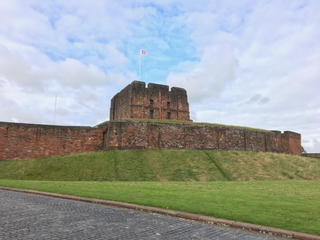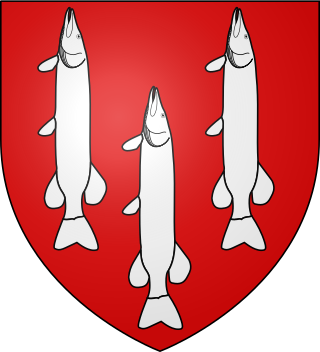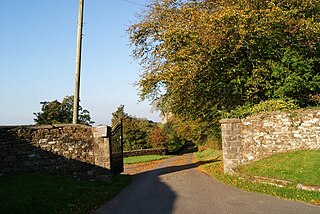
The Court of King's Bench was one of the senior courts of common law in Ireland. It was a mirror of the Court of King's Bench in England. The Lord Chief Justice was the most senior judge in the court, and the second most senior Irish judge under English rule and later when Ireland became part of the United Kingdom. Additionally, for a brief period between 1922 and 1924, the Lord Chief Justice of Ireland was the most senior judge in the Irish Free State.

Carlisle Castle is a medieval stone keep fortress located in the city of Carlisle near the ruins of Hadrian's Wall. First built during the reign of William II in 1092 and rebuilt in stone under Henry I in 1122, the castle is over 930 years old and has been the scene of many episodes in British history.
Walter Mauclerk was a medieval Bishop of Carlisle and Lord High Treasurer of England.
The sheriff is the oldest secular office under the Crown. Formerly the sheriff was the principal law enforcement officer in the county but over the centuries most of the responsibilities associated with the post have been transferred elsewhere or are now defunct so that its functions are now largely ceremonial. The sheriff changes every April.
Sir Thomas Moulton was an English landowner, knight, admiral and judge during the reigns of King John and King Henry III. From a family with landholdings in the south of Lincolnshire, he was the son and heir of Thomas Moulton and his wife Eleanor Boston. After initial military service, he became a senior judge and held important government positions, in the process extending his inherited estates and accumulating considerable wealth.

de Lucy or de Luci is the surname of an old Norman noble family originating from Lucé in Normandy, one of the great baronial Anglo-Norman families which became rooted in England after the Norman conquest. The first records are about Adrian de Luci who went into England after William the Conqueror. The rise of this family might have been due to Henry I of England, although there are no historical proofs that all de Lucys belonged to the same family. The family name is Gallo-Roman, mentioned in 616 as Luciacus, Lucy, Luci, Lucé derive from the Latin cognomen Lucius, meaning "born with the daylight" or Gaulish Lucus, Lucius, Lucco from Loco- / Luco- possibly "wolf" + suffix -(i)acum "place, property" of Gaulish origin.

Anthony de Lucy, 1st Baron Lucy was an English nobleman who served as warden of Carlisle Castle and Chief Justiciar of Ireland.
Sir Robert Dillon of Riverston was an Irish lawyer, judge, and politician. He came from a family with a distinguished record of judicial service. He pursued a successful career as a judge, which was, however, dogged by accusations of corruption and other serious wrongdoing, of which the worst was that he had falsely condemned Nicholas Nugent, another judge and rival, to death. Sir Robert Dillon, the subject of this article, must not be confused with an earlier Sir Robert Dillon of Newtown, his grand-uncle, who was also Chief Justice of the Irish Common Pleas.
Sir Thomas Luttrell was a wealthy Anglo-Irish landowner of the sixteenth-century Irish Pale. He was also a distinguished lawyer and judge who held the offices of King's Serjeant, Solicitor General for Ireland and Chief Justice of the Irish Common Pleas.

The Court of Common Pleas was one of the principal courts of common law in Ireland. It was a mirror image of the equivalent court in England. Common Pleas was one of the four courts of justice which gave the Four Courts in Dublin, which is still in use as a courthouse, its name. Its remit as in England was to hear lawsuits between ordinary citizens.
Sir Lucas Dillon, also called Luke, was a leading Irish barrister and judge of the Elizabethan era who held the offices of Attorney General for Ireland and Chief Baron of the Irish Exchequer. He supported the Lord Deputy Henry Sidney in the cess controversy and the Lord Deputy John Perrot in the Desmond Rebellions. He was held in high regard by Queen Elizabeth, but was accused by his enemies of corruption and maladministration.
Sir Robert Bagod was an Irish judge who was appointed the first Chief Justice of the Irish Common Pleas in 1276. He built Baggotrath Castle, which was the strongest fortress in Dublin: it was located on present-day Baggot Street in central Dublin. He also founded the Carmelite Friary in Dublin.

Scaleby Castle is in the village of Scaleby, Cumbria, England. The castle was originally built in the early 14th century, and extended in the 15th century to form a substantial fortification. Parliamentary troops attacked the castle twice during the English Civil War, burning it. It was later restored to form a country house.
Robert de Holywood was an Irish judge and landowner who held the office of Chief Baron of the Irish Exchequer. He was the ancestor of the Holywood family of Artane Castle, and of the St. Lawrence family, Earls of Howth. He was a substantial landowner with property in Dublin, Meath and Louth. He became extremely unpopular, and was removed from office after numerous complaints of "oppression and extortion" were made against him. These were apparently inspired ĺargely by his close association in the mid-1370s with Sir William de Windsor, the embattled Lord Lieutenant of Ireland.
Sir Richard Lowther of Lowther Hall, Westmorland was an English soldier and official. He was twice High Sheriff of Cumberland and Lord Warden of the West March in 1592.

Godfrey Boate was an Irish judge: he is mainly remembered now for incurring the enmity of Jonathan Swift, who celebrated Boate's death with the mocking Quibbling Elegy on Judge Boat.

Hayton Castle is a fortified house situated to the North-East of the village of Hayton in Cumbria.

The Blennerhassett family is an English and Anglo-Irish noble family which has been involved in the politics of the Britain and Ireland since the fourteenth century. The male line of the family is extinct in Britain.
Nicholas de Meones or de Moenes was an Irish judge of the fourteenth century. He had a somewhat turbulent career, due to his political partisanship, and was briefly imprisoned on a charge of treason.

Waleran de Wellesley was a judge, statesman and landowner in thirteenth century Ireland. He was a member of the Privy Council of Ireland. He was the ancestor of the Duke of Wellington, and was the first of the de Wellesley family to settle in Ireland.









